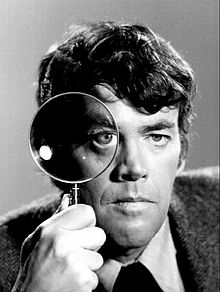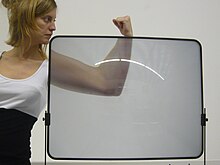|
Magnifying glass
  A magnifying glass is a convex lens that is used to produce a magnified image of an object. The lens is usually mounted in a frame with a handle. Beyond its primary function of magnification, this simple yet ingenious tool serves a variety of purposes. It can be employed to focus sunlight, harnessing the Sun's rays to create a concentrated hot spot at the lens's focus, which is often used for starting fires. In another innovative form, the magnifying glass can manifest as a sheet magnifier, employing numerous slender, concentric, ring-shaped lenses. These are collectively known as a Fresnel lens, which, despite being significantly thinner, operates effectively as a single lens. This particular design finds its utility in applications such as screen magnifiers for TVs, offering a lightweight and efficient solution for enlarging visuals.  The cultural impact of the magnifying glass extends far into the realms of literature and pop culture, symbolizing the pursuit of truth and the uncovering of secrets. It is famously associated with the investigative work of fictional detectives, with Sherlock Holmes being the most iconic figure to wield it, cementing its status as an emblem of detective fiction. Through its various forms and functions, the magnifying glass remains a tool of both practical utility and significant symbolic value. History "The evidence indicates that the use of lenses was widespread throughout the Middle East and the Mediterranean basin over several millennia".[1] Archaeological findings from the 1980s in Crete's Idaean Cave unearthed rock crystal lenses dating back to the Archaic Greek period, showcasing exceptional optical quality. These discoveries suggest that the use of lenses for magnification and possibly for starting fires was widespread in the Mediterranean and Middle East, indicating an advanced understanding of optics in antiquity.[2] The earliest explicit written evidence of a magnifying device is a joke in Aristophanes's The Clouds[3] from 424 BC, where magnifying lenses to ignite tinder were sold in a pharmacy, and Pliny the Elder's "lens",[4] a glass globe filled with water, used to cauterize wounds. (Seneca wrote that it could be used to read letters "no matter how small or dim".[5][6]) A convex lens used for forming a magnified image was described in the Book of Optics by Ibn al-Haytham in 1021.[7][verification needed] After the book was translated during the Latin translations of the 12th century, Roger Bacon described the properties of a magnifying glass in 13th-century England. This was followed by the development of eyeglasses in 13th-century Italy.[7] Building on this foundation, in the late 1500s, two Dutch spectacle makers Jacob Metius and Zacharias Janssen crafted the compound microscope by assembling several magnifying lenses in a tube, marking a significant advancement in optical instruments. Not long after, Hans Lipperhey introduced the telescope in 1608 and Galileo Galilei improving on the device in 1609, employing the magnifying lens in an innovative manner, further extending the application of optical technologies developed through the ages.[8] Magnification The magnification of a magnifying glass depends upon where it is placed between the user's eye and the object being viewed, and the total distance between them. The magnifying power is equivalent to angular magnification (this should not be confused with optical power, which is a different quantity). The magnifying power is the ratio of the sizes of the images formed on the user's retina with and without the lens.[9] For the "without" case, it is typically assumed that the user would bring the object as close to one eye as possible without it becoming blurry. This point, known as the near point of accommodation, varies with age. In a young child, it can be as close as 5 cm, while, in an elderly person it may be as far as one or two metres. Magnifiers are typically characterized using a "standard" value of 0.25 m. A magnifying glass operates as the simplest form of optical instrument. It is essentially a hand-held lens that converges light to produce an enlarged, upright image that appears to stand where light doesn't actually converge, known as a 'virtual' image. To view an item in greater detail, it is positioned between the lens and its focal point, and the optimal observation occurs when the image is at the closest distance at which the eye can focus comfortably. The lens's magnification is the ratio of the image's apparent height to the object's actual height, correlating to the proportion of the distances from the image to the lens and the object to the lens. Moving the object nearer to the lens amplifies this effect, increasing magnification.[10] The highest magnifying power is obtained by putting the lens very close to one eye, and moving the eye and the lens together to obtain the best focus. The object will then typically also be close to the lens. The magnifying power obtained in this condition is MP0 = (0.25 m)Φ + 1, where Φ is the optical power in dioptres, and the factor of 0.25 m represents the assumed near point (¼ m from the eye). This value of the magnifying power is the one normally used to characterize magnifiers. It is typically denoted "m×", where m = MP0. This is sometimes called the total power of the magnifier (again, not to be confused with optical power). However, magnifiers are not always used as described above because it is more comfortable to put the magnifier close to the object (one focal length away). The eye can then be a larger distance away, and a good image can be obtained very easily; the focus is not very sensitive to the eye's exact position. The magnifying power in this case is roughly MP = (0.25 m)Φ. A typical magnifying glass might have a focal length of 25 cm, corresponding to an optical power of 4 dioptres. Such a magnifier would be sold as a "2×" magnifier. In actual use, an observer with "typical" eyes would obtain a magnifying power between 1 and 2, depending on where lens is held. Practical usesA magnifying glass can serve as a fire-starting tool in survival situations. Any transparent lens with significant magnifying ability, such as a standard magnifying glass or a jeweler's loupe, can concentrate sunlight to ignite tinder. The technique involves positioning the lens to focus a small, intense spot of light onto the tinder, awaiting ignition with patience. The advantage of this method is the simplicity of the lens and the minimal effort required. However, its effectiveness is contingent upon clear, strong sunlight, which may be inconsistent depending on geographic location and time of year.[11] Beyond survival uses, magnifying glasses are invaluable tools for jewelers and hobbyists. Jewelers rely on them to scrutinize the quality and authenticity of precious gems, ensuring accurate evaluations. Hobbyists, from those engaged in sewing and needlework to stamp collectors, depend on magnifying glasses for detailed work, enhancing both precision and enjoyment. This versatility underlines the magnifying glass's enduring utility across a spectrum of activities, from professional assessments to leisure pursuits.[8] Advanced digital magnifiers and apps have emerged as modern alternatives to traditional magnifying glasses, offering features such as variable magnification levels, high-contrast modes, and text-to-speech for visually impaired users. These tools not only magnify text and objects but also enhance readability and accessibility, making them invaluable for daily living and educational purposes.[12][13] AlternativesMagnifying glasses typically have low magnifying power: 2×–6×, with the lower-power types being much more common. At higher magnifications, the image quality of a simple magnifying glass becomes poor due to optical aberrations, particularly spherical aberration. When more magnification or a better image is required, other types of hand magnifier are typically used. A Coddington magnifier provides higher magnification with improved image quality. Even better images can be obtained with a multiple-lens magnifier, such as a Hastings triplet. High power magnifiers are sometimes mounted in a cylindrical or conical holder with no handle, often designed to be worn on the head; this is called a loupe. Such magnifiers can reach up to about 30×, and at these magnifications the aperture of the magnifier becomes very small and it must be placed very close to both the object and the eye. For more convenient use or for magnification beyond about 30×, a microscope is necessary. Fresnel lenses are used as magnifiers, for example for reading printed text. Use as a symbolThe magnifying glass icon (🔍), represented by U+1F50D in Unicode, has evolved into a universal symbol for searching and zooming functions in digital interfaces. Originating from its practical use for detailed examination and discovery, it has been adopted by modern computer software and websites to denote tools for users to find information or closely inspect content.[9][10] The right-pointing version, U+1F50E (🔎), continues this theme, often used to initiate searches. The integration of these icons into user interface design reflects the intuitive connection between the physical act of magnifying to see more clearly and the metaphorical act of searching for information in the digital space.[14] Beyond its digital symbolization for search functions, the magnifying glass also holds a place in educational symbolism, often representing curiosity, exploration, and the quest for knowledge. Educational institutions and programs frequently use the magnifying glass in logos and materials to emphasize the importance of inquiry and discovery in learning.[15] See alsoWikimedia Commons has media related to Magnifying glasses.
References
|